All Exams >
Class 10 >
Science Class 10 >
All Questions
All questions of Electricity for Class 10 Exam
Can you explain the answer of this question below:Four resistors of 4 ohm each are connected in parallel, four such combinations are then connected in series. Their total resistance is- A:16Ω
- B:4Ω
- C:12Ω
- D:20Ω
The answer is b.
Four resistors of 4 ohm each are connected in parallel, four such combinations are then connected in series. Their total resistance is
A:
16Ω
B:
4Ω
C:
12Ω
D:
20Ω
|
|
Anjana Khatri answered |
1/R = 1/4 + 1/4 + 1/4 + 1/4= 4/4= R = 1ΩThen, four such combination are connected in series Rtotal = 1 + 1 + 1 +1 = 4 Ω
To get 2Ω resistance using only 6Ω resistors, the number of them required is- a)2
- b)3
- c)4
- d)6
Correct answer is option 'B'. Can you explain this answer?
To get 2Ω resistance using only 6Ω resistors, the number of them required is
a)
2
b)
3
c)
4
d)
6
|
|
Avinash Patel answered |
Three resistors of 2Ω is required to get 6Ω because resultant is more than individual so they all must be connected in series.
The potential difference of a circuit is constant. If the resistance of a circuit is doubled, then its current will become;- a)4 I
- b)I/2
- c)2 I
- d)I
Correct answer is 'B'. Can you explain this answer?
The potential difference of a circuit is constant. If the resistance of a circuit is doubled, then its current will become;
a)
4 I
b)
I/2
c)
2 I
d)
I
|
|
Nisha Choudhury answered |
According to ohm's law
Current (I) = Potential difference (V) / Resistance(R)
If the potential difference is maintained constant and the resistance is changed,
Cureent (I) is inversely proportinal to the reisistance (R)
V = IR --(1)
Now, here V is constant.
Let , new resistance R' = 2R and assume that current flow be I'
So, from (1),
IR = I'. R',
=> IR = I'. 2R,
Therefore, I' = I / 2
So,
If the resistance is doubled by applying the constant potential difference the current becomes the half of the previous.
An electric refrigerator rated 500 W operates 10 hr per day. What is the cost of the energy to operate it for 30 days at Rs. 4.00 per kWh?- a)Rs. 600
- b)Rs. 400
- c)Rs. 500
- d)Rs. 800
Correct answer is option 'A'. Can you explain this answer?
An electric refrigerator rated 500 W operates 10 hr per day. What is the cost of the energy to operate it for 30 days at Rs. 4.00 per kWh?
a)
Rs. 600
b)
Rs. 400
c)
Rs. 500
d)
Rs. 800
|
|
Aditya Shah answered |
E = P × t = 0.5 × 10 × 30 = 150 kWh
Cost of energy = 150 × 4 = Rs. 600
Cost of energy = 150 × 4 = Rs. 600
The effective resistance between A and B is
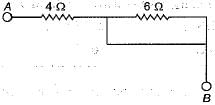
- a)4Ω
- b)6Ω
- c)May be 10Ω
- d)Must be 10Ω
Correct answer is option 'A'. Can you explain this answer?
The effective resistance between A and B is


a)
4Ω
b)
6Ω
c)
May be 10Ω
d)
Must be 10Ω
|
|
Gaurav Kumar answered |
6Ω is shorted
as current will pass from wire having no resistance
so effective resistance is 4Ω.
as current will pass from wire having no resistance
so effective resistance is 4Ω.
Calculate the current flows through the 10Ω resistor in the following circuit.
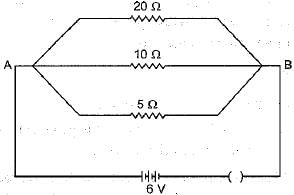
- a)1.2A
- b)0.6A
- c)0.2A
- d)2.0A
Correct answer is option 'B'. Can you explain this answer?
Calculate the current flows through the 10Ω resistor in the following circuit.


a)
1.2A
b)
0.6A
c)
0.2A
d)
2.0A

|
Sun Ray Institute answered |
In parallel, potential difference across each resistor will remain same. So, current through 10Ω resistor


Four resistors of 4 ohm each are connected in parallel, four such combinations are then connected in series. Their total resistance is- a)16Ω
- b)4Ω
- c)12Ω
- d)20Ω
Correct answer is 'B'. Can you explain this answer?
Four resistors of 4 ohm each are connected in parallel, four such combinations are then connected in series. Their total resistance is
a)
16Ω
b)
4Ω
c)
12Ω
d)
20Ω

|
Srishti Singh answered |
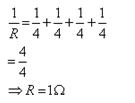
Then, four such combination are connected in series Rtotal = 1 + 1 + 1 +1 = 4 Ω
The combined resistance of 6Ω and 12Ω connected in parallel is
- A:
6 Ω
- B:
2 Ω
- C:
18 Ω
- D:
4 Ω
The answer is d.
6 Ω
2 Ω
18 Ω
4 Ω
|
|
Raghav Bansal answered |
Explanation:- In parallel, we know ;
1/ R p = 1/R1 + 1/R2 + ----------
1/ Rp = 1/ 6 + 1/12
1/ Rp = 1/ 4
Therefore , Rp = 4 ohm.
1/ R p = 1/R1 + 1/R2 + ----------
1/ Rp = 1/ 6 + 1/12
1/ Rp = 1/ 4
Therefore , Rp = 4 ohm.
If four resistors each of 1Ω are connected in parallel, the effective resistance will be- a)0.5Ω
- b)0.25Ω
- c)4Ω
- d)2Ω
Correct answer is option 'B'. Can you explain this answer?
If four resistors each of 1Ω are connected in parallel, the effective resistance will be
a)
0.5Ω
b)
0.25Ω
c)
4Ω
d)
2Ω
|
|
Gaurav Kumar answered |
If four resistors each of 1Ω are connected in parallel, the effective resistance will be 0.25Ω..
As, in parralel connection,
1/Reff. = 1/R1 + 1/R2 + ....
Conventional direction of electric current is from- a)Lower potential to higher potential
- b)Higher resistance to lower resistance
- c)Positive to negative terminal
- d)Negative to positive terminal
Correct answer is 'C'. Can you explain this answer?
Conventional direction of electric current is from
a)
Lower potential to higher potential
b)
Higher resistance to lower resistance
c)
Positive to negative terminal
d)
Negative to positive terminal
|
|
C K Academy answered |
The current in the wire is due to the drifting of electrons inside a wire in a direction opposite to the flow of electrons. During their drifting they collide with their atoms vibrating about their mean position and lose some of kinetic energy to the vibrating atoms.
The electrons are negatively charged particles and so, the electrons move towards the positively charged terminal from the negatively charged terminal.
Hence, the statement is true as the conventional direction of flow of current is from positive terminal to negative terminal of the cell.
The electrons are negatively charged particles and so, the electrons move towards the positively charged terminal from the negatively charged terminal.
Hence, the statement is true as the conventional direction of flow of current is from positive terminal to negative terminal of the cell.
The water heating rod draws 10 A current when connected to certain power source. The resistance of rod is 12 Ω. The source voltage is:- a)1.2 V
- b)120 V
- c)1200 V
- d)None of these
Correct answer is option 'B'. Can you explain this answer?
The water heating rod draws 10 A current when connected to certain power source. The resistance of rod is 12 Ω. The source voltage is:
a)
1.2 V
b)
120 V
c)
1200 V
d)
None of these
|
|
Aditya Kumar answered |
The correct answer is B as Ohm's law:
voltage=current x resistance=12x10=120 V
voltage=current x resistance=12x10=120 V
Directions: In the following questions, a statement of assertion (A) is followed by a statement of reason (R). Mark the correct choice as:Assertion : Silver is not used to make electric wires.Reason : Silver is a bad conductor.- a)Both assertion (A) and reason (R) are true and reason (R) is the correct explanation of assertion (A).
- b)Both assertion (A) and reason (R) are true but reason (R) is not the correct explanation of assertion (A).
- c)Assertion (A) is true but reason (R) is false.
- d)Assertion (A) is false but reason (R) is true.
- e)Both Assertion and Reason are false.
Correct answer is option 'C'. Can you explain this answer?
Directions: In the following questions, a statement of assertion (A) is followed by a statement of reason (R). Mark the correct choice as:
Assertion : Silver is not used to make electric wires.
Reason : Silver is a bad conductor.
a)
Both assertion (A) and reason (R) are true and reason (R) is the correct explanation of assertion (A).
b)
Both assertion (A) and reason (R) are true but reason (R) is not the correct explanation of assertion (A).
c)
Assertion (A) is true but reason (R) is false.
d)
Assertion (A) is false but reason (R) is true.
e)
Both Assertion and Reason are false.
|
|
Ananya Das answered |
Silver is a good conductor of electricity but it is not used to make electric wires because it is expensive.
Two resistors 4Ω and 2Ω are connected in series, and potential difference of 12 V is applied across the combination. Then, the current through the circuit is:- a)4.5 A
- b)4 A
- c)2 A
- d)1 A
Correct answer is option 'C'. Can you explain this answer?
Two resistors 4Ω and 2Ω are connected in series, and potential difference of 12 V is applied across the combination. Then, the current through the circuit is:
a)
4.5 A
b)
4 A
c)
2 A
d)
1 A
|
|
Ananya Das answered |
Total resistance =4+2
=6
Current =V/R = 12/6
=2A
=6
Current =V/R = 12/6
=2A
Can you explain the answer of this question below:How much work is done, when 1 coulomb of charge moves against a potential difference of 1 volt?
- A:
1 joule
- B:
2 joule
- C:
0.5 joule
- D:
1.5 joule
The answer is a.
How much work is done, when 1 coulomb of charge moves against a potential difference of 1 volt?
1 joule
2 joule
0.5 joule
1.5 joule
|
|
Arun Yadav answered |
Charge moved, Q = 1 C
Potential difference, V = 1V
Therefore,
Work done, W = QV
= 1 C x 1 V
= 1 joule.
A wire of resistance 8Ω is bent in the form of a closed circle. What is the effective resistance between the two points A and B, at the ends of any diameter of the circle ?
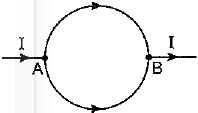
- a)8Ω
- b)4Ω
- c)2Ω
- d)1Ω
Correct answer is option 'C'. Can you explain this answer?
A wire of resistance 8Ω is bent in the form of a closed circle. What is the effective resistance between the two points A and B, at the ends of any diameter of the circle ?


a)
8Ω
b)
4Ω
c)
2Ω
d)
1Ω

|
Flembe Academy answered |
When a wire of 8Ω resistance is bent in the form of a closed circle, resistance of each half (semicircular) part is 8/2 Ω = 4Ω.
As these two parts are connected in parallel across points A and B, hence effective resistance will be 2Ω.
As these two parts are connected in parallel across points A and B, hence effective resistance will be 2Ω.
The resistance whose V - I graph is given below is
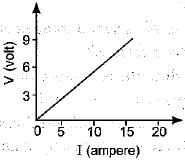
- a)

- b)

- c)

- d)

Correct answer is option 'B'. Can you explain this answer?
The resistance whose V - I graph is given below is


a)

b)

c)

d)

|
|
Prachi shukla answered |
Resistance = slope line of V-I graph


A resistance wire is stretched so as to double its length. Its new resistivity will have a magnitude- a)2 times its original value
- b)4 times its original value
- c)8 times its original valu
- d)same as its original value
Correct answer is option 'D'. Can you explain this answer?
A resistance wire is stretched so as to double its length. Its new resistivity will have a magnitude
a)
2 times its original value
b)
4 times its original value
c)
8 times its original valu
d)
same as its original value
|
|
Anita Menon answered |
When a wire is stretched, its resistivity remains unchanged. It is because resistivity of a conductor depends only on its material and is independent of its length or cross- section area.
All elements of an electric circuit are connected in series except :- a)voltmeter
- b)ammeter
- c)rheostat
- d)resistor
Correct answer is option 'A'. Can you explain this answer?
All elements of an electric circuit are connected in series except :
a)
voltmeter
b)
ammeter
c)
rheostat
d)
resistor
|
|
Ishan Choudhury answered |
In an electric circuit all other elements are connected in series but a voltmeter is connected in parallel.
A bulb draws a current of 0.20 A for 15 minutes. What is the amount of electric charge that flows through it ?
- a)180 C
- b)182 C
- c)200 C
- d)300 C
Correct answer is option 'A'. Can you explain this answer?
A bulb draws a current of 0.20 A for 15 minutes. What is the amount of electric charge that flows through it ?
a)
180 C
b)
182 C
c)
200 C
d)
300 C
|
|
Rajiv Gupta answered |
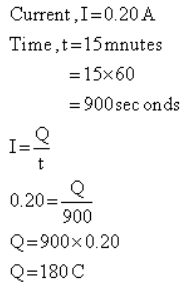
The amount of electric charge that flows through the bulb =180 C.
A cooler of 1500 W, 200 volt and a fan of 500 W, 200 volt are to be used from a household supply. The rating of fuse to be used is- a)2.5 A
- b)5.0 A
- c)7.5 A
- d)10 A
Correct answer is option 'D'. Can you explain this answer?
A cooler of 1500 W, 200 volt and a fan of 500 W, 200 volt are to be used from a household supply. The rating of fuse to be used is
a)
2.5 A
b)
5.0 A
c)
7.5 A
d)
10 A
|
|
Shreyas murthy answered |
Total power used, P - P1 + P2 = 1500 + 500 = 2000 W.
Current drawn from the supply,

Current drawn from the supply,

How much heat energy is produced in 10 second in an electric iron having resistance 440 Ω, when a potential difference of 220 volt is applied across it?- a)1200 J
- b)600 J
- c)1000 J
- d)1100 J
Correct answer is option 'D'. Can you explain this answer?
How much heat energy is produced in 10 second in an electric iron having resistance 440 Ω, when a potential difference of 220 volt is applied across it?
a)
1200 J
b)
600 J
c)
1000 J
d)
1100 J

|
Imk Pathshala answered |
From ohm’s law, I = V/R = 220/440 = 0.5 A
H = I2 × R × t = (0.5)2 × 440 × 10 = 1100 J
Two devices are connected between two points say A and B in parallel. The physical quantity that will remain the same between the two points is- a)current
- b)voltage
- c)resistance
- d)None of these
Correct answer is option 'B'. Can you explain this answer?
Two devices are connected between two points say A and B in parallel. The physical quantity that will remain the same between the two points is
a)
current
b)
voltage
c)
resistance
d)
None of these
|
|
Meera Rana answered |
In parallel combination voltage remains same across two points.
The opposing capacity of materials against the current flow is- a)Conductance
- b)Inductance
- c)Susceptance
- d)Resistance
Correct answer is option 'D'. Can you explain this answer?
The opposing capacity of materials against the current flow is
a)
Conductance
b)
Inductance
c)
Susceptance
d)
Resistance
|
|
Rahul Kapoor answered |
The electrical resistance of an electrical conductor is a measure of the difficulty to pass an electric current through that conductor.
Resistance in a conductor can be defined as the opposition offered to the flow of electrons. For a conductor of uniform cross-sectional area resistance is directly proportional to the length of the conductor and inversely proportional to the cross-sectional area of the conductor.
A combination of three resistances has been shown here. Effective resistance between the points A and B is

- a)8Ω
- b)4Ω
- c)2Ω
- d)1Ω
Correct answer is option 'C'. Can you explain this answer?
A combination of three resistances has been shown here. Effective resistance between the points A and B is


a)
8Ω
b)
4Ω
c)
2Ω
d)
1Ω
|
|
Pooja Shah answered |
Value of series combination of 2Ω and 2Ω resistances = 4Ω. As it is now connected in parallel to 4Ω resistance, hence the effective resistance R between the points A and B will be


SI unit of resistivity is- a)ohm/metre
- b)ohm-metre
- c)ohm/(metre)3
- d)ohm/(metre)2
Correct answer is option 'B'. Can you explain this answer?
SI unit of resistivity is
a)
ohm/metre
b)
ohm-metre
c)
ohm/(metre)3
d)
ohm/(metre)2
|
|
Krishna Iyer answered |
As resistivity of the material of a resistor of length l, cross-section area A and resistance R is given by :ρ = R.A/I, hence SI unit of resistivity is ohm -metre (Ω m).
How much energy is transferred when 10 A current flows through a resistor of 5 ohm for 30 minutes?- a)0.25 kWh
- b)1.2 kWh
- c)0.025 kWh
- d)3.2 kWh
Correct answer is option 'A'. Can you explain this answer?
How much energy is transferred when 10 A current flows through a resistor of 5 ohm for 30 minutes?
a)
0.25 kWh
b)
1.2 kWh
c)
0.025 kWh
d)
3.2 kWh
|
|
Pooja Shah answered |
P = I2 R = (10)2 × 5 = 500 watt = 0.5 kW
t = 30 minute = 0.5 hr
E = P × t = 0.5 kW × 0.5 hr = 0.25 kWh
The resistance of a conductor increases with-
I: Increase in length
II: Increase in volume
III: Decrease in area- a)I or III
- b)II only
- c)I or II
- d)III only
Correct answer is option 'A'. Can you explain this answer?
The resistance of a conductor increases with-
I: Increase in length
II: Increase in volume
III: Decrease in area
I: Increase in length
II: Increase in volume
III: Decrease in area
a)
I or III
b)
II only
c)
I or II
d)
III only
|
|
💐 answered |
Resistance is directly proportional to Length nd inversely proportional to Area
Hence , resistance increase with increase in area nd increases with decrease in area !!!
Hence , resistance increase with increase in area nd increases with decrease in area !!!
A coil in the heater consume power P on passing current. If it is cut into halves and joined in parallel, it will consume power- a)P
- b)P/2
- c)2P
- d)4P
Correct answer is option 'D'. Can you explain this answer?
A coil in the heater consume power P on passing current. If it is cut into halves and joined in parallel, it will consume power
a)
P
b)
P/2
c)
2P
d)
4P
|
|
Pooja Shah answered |
Original power consumed, P = V2/R
When used in parallel

RP = R/4
∴ New power consumed when two halves in parallel

When used in parallel

RP = R/4
∴ New power consumed when two halves in parallel

A fuse wire repeatedly gets burnt when used with a good heater. It is advised to use a fuse wire of- a)more length
- b)less radius
- c)less length
- d)more radius
Correct answer is option 'D'. Can you explain this answer?
A fuse wire repeatedly gets burnt when used with a good heater. It is advised to use a fuse wire of
a)
more length
b)
less radius
c)
less length
d)
more radius
|
|
Pallavi kapoor answered |
In order to get the working of heater properly, fused wire of higher rating must be used.
A certain wire has a resistance R. The resistance of another wire identical with the first and having twice its diameter is;- a)0.5 R
- b)0.25 R
- c)4 R
- d)2 R
Correct answer is option 'B'. Can you explain this answer?
A certain wire has a resistance R. The resistance of another wire identical with the first and having twice its diameter is;
a)
0.5 R
b)
0.25 R
c)
4 R
d)
2 R
|
|
Rahul Kapoor answered |
Resistance of a wire is inversely proportional to the cross−sectional area:
R α 1/A
α 1/πd^2/4
α 1/d^2
R'/R = (d/d')^2
R'= R(d/2d)^2
= R/4
= 0.25 R
The resistance of an alloy :- a)increases with temperature
- b)decreases with temperature
- c)is constant with rise in temperature
- d)is zero
Correct answer is option 'A'. Can you explain this answer?
The resistance of an alloy :
a)
increases with temperature
b)
decreases with temperature
c)
is constant with rise in temperature
d)
is zero
|
|
Bibek Iyer answered |
The resistance of an alloy increases with temperature.
When an electric current flows through a material, it encounters resistance, which is the opposition to the flow of electric charge. The resistance of a material depends on various factors, including temperature.
The resistance of most materials, including metals and alloys, increases with an increase in temperature. This phenomenon is referred to as the positive temperature coefficient of resistance.
Factors contributing to the increase in resistance with temperature:
As the temperature of a material increases, the atoms or ions in the material gain thermal energy and start vibrating more vigorously. This increased atomic vibration leads to more frequent collisions between the moving electrons and the vibrating atoms. These collisions impede the flow of electrons, increasing the resistance.
The increased atomic vibrations also result in more collisions between the electrons and the atoms. These collisions scatter the electrons, making it more difficult for them to move through the material. Consequently, the resistance of the material increases.
At higher temperatures, the electron mobility, which is the ability of electrons to move freely in a material, decreases. This decrease in electron mobility further contributes to the increase in resistance.
There are a few materials, such as certain semiconductors and superconductors, that exhibit a negative temperature coefficient of resistance. In these materials, the resistance decreases with an increase in temperature.
In the case of alloys, which are typically metallic substances composed of two or more elements, the resistance increases with temperature due to the increased atomic vibrations, electron-atom collisions, and reduced electron mobility. This phenomenon is important to consider in various applications, such as electrical circuits and devices, where temperature changes can affect the overall performance and efficiency.
Explanation:
When an electric current flows through a material, it encounters resistance, which is the opposition to the flow of electric charge. The resistance of a material depends on various factors, including temperature.
Effect of Temperature on Resistance:
The resistance of most materials, including metals and alloys, increases with an increase in temperature. This phenomenon is referred to as the positive temperature coefficient of resistance.
Factors contributing to the increase in resistance with temperature:
1. Atomic Vibrations:
As the temperature of a material increases, the atoms or ions in the material gain thermal energy and start vibrating more vigorously. This increased atomic vibration leads to more frequent collisions between the moving electrons and the vibrating atoms. These collisions impede the flow of electrons, increasing the resistance.
2. Electron-Atom Collisions:
The increased atomic vibrations also result in more collisions between the electrons and the atoms. These collisions scatter the electrons, making it more difficult for them to move through the material. Consequently, the resistance of the material increases.
3. Changes in Electron Mobility:
At higher temperatures, the electron mobility, which is the ability of electrons to move freely in a material, decreases. This decrease in electron mobility further contributes to the increase in resistance.
Exceptions:
There are a few materials, such as certain semiconductors and superconductors, that exhibit a negative temperature coefficient of resistance. In these materials, the resistance decreases with an increase in temperature.
Conclusion:
In the case of alloys, which are typically metallic substances composed of two or more elements, the resistance increases with temperature due to the increased atomic vibrations, electron-atom collisions, and reduced electron mobility. This phenomenon is important to consider in various applications, such as electrical circuits and devices, where temperature changes can affect the overall performance and efficiency.
If R1 and R2 be the resistance of the filament of 40 W and 60 W respectively operating 220 V, then- a)R1 < R2
- b)R2 < R1
- c)R1 = R2
- d)R1 ≥ R2
Correct answer is option 'B'. Can you explain this answer?
If R1 and R2 be the resistance of the filament of 40 W and 60 W respectively operating 220 V, then
a)
R1 < R2
b)
R2 < R1
c)
R1 = R2
d)
R1 ≥ R2
|
|
Ritu Saxena answered |
Using power,

For the same voltage, R ∝ 1/P
More the power, lesser the resistance.
Accordingly, R2 < R1

For the same voltage, R ∝ 1/P
More the power, lesser the resistance.
Accordingly, R2 < R1
Two light bulbs P and Q are identical in all respects, except that P’s filament is thicker than Q’s. If the same potential difference is applied to each, then- a)P will burn brighter because it has the lower resistance
- b)Q will burn brighter because it has the lower resistance.
- c)Q will burn brighter because it has the greater resistance.
- d)P will burn brighter because it has the greater resistance.
Correct answer is 'A'. Can you explain this answer?
Two light bulbs P and Q are identical in all respects, except that P’s filament is thicker than Q’s. If the same potential difference is applied to each, then
a)
P will burn brighter because it has the lower resistance
b)
Q will burn brighter because it has the lower resistance.
c)
Q will burn brighter because it has the greater resistance.
d)
P will burn brighter because it has the greater resistance.
|
|
Divyansh Mehta answered |
Explanation:
When the same potential difference is applied to two light bulbs, the bulb with lower resistance will draw more current and dissipate more power, causing it to shine brighter.
The resistance of a conductor is directly proportional to its length and inversely proportional to its cross-sectional area. Therefore, thicker filaments have lower resistance than thinner filaments.
Reasoning:
P has a thicker filament than Q, which means it has a lower resistance. Therefore, P will draw more current and dissipate more power than Q, causing it to shine brighter.
Q has a thinner filament than P, which means it has a higher resistance. Therefore, Q will draw less current and dissipate less power than P, causing it to shine dimmer.
Answer:
Hence, the correct answer is option A, which states that P will burn brighter because it has the lower resistance.
When the same potential difference is applied to two light bulbs, the bulb with lower resistance will draw more current and dissipate more power, causing it to shine brighter.
The resistance of a conductor is directly proportional to its length and inversely proportional to its cross-sectional area. Therefore, thicker filaments have lower resistance than thinner filaments.
Reasoning:
P has a thicker filament than Q, which means it has a lower resistance. Therefore, P will draw more current and dissipate more power than Q, causing it to shine brighter.
Q has a thinner filament than P, which means it has a higher resistance. Therefore, Q will draw less current and dissipate less power than P, causing it to shine dimmer.
Answer:
Hence, the correct answer is option A, which states that P will burn brighter because it has the lower resistance.
Resistivity of a given conductor depends on- a)length of conductor
- b)length as well as cross-section area of conductor
- c)material and dimensions, of conductor
- d)material of conductor and temperature
Correct answer is option 'D'. Can you explain this answer?
Resistivity of a given conductor depends on
a)
length of conductor
b)
length as well as cross-section area of conductor
c)
material and dimensions, of conductor
d)
material of conductor and temperature
|
|
Krishna Iyer answered |
Resistivity of a given conductor depends only on its material and the temperature. Resistivity does not depend on the dimensions of the conductor.
Commercial unit of electric energy is- a)volt
- b)joule
- c)watt
- d)Kilowatt-hour
Correct answer is option 'D'. Can you explain this answer?
Commercial unit of electric energy is
a)
volt
b)
joule
c)
watt
d)
Kilowatt-hour

|
Surbhi Gupta answered |
The commercial unit of electrical energy is kilowatt hour.
Which of the following terms does not represent electrical power in a circuit?- a)V2/R
- b)I2R
- c)IR2
- d)VI
Correct answer is option 'C'. Can you explain this answer?
Which of the following terms does not represent electrical power in a circuit?
a)
V2/R
b)
I2R
c)
IR2
d)
VI
|
|
Nisha Choudhury answered |
Electric power in terms of current = IR2 and in terms of voltage = V2/R and in terms of voltage and current both = VI
An electric bulb is marked 18watt-240 volt. If it is used across 240 V power line for one hour daily, calculate the number of days to consume 1 unit of electric energy.- a)54.5 days
- b)57.5 days
- c)50.5 days
- d)55.5 days
Correct answer is 'D'. Can you explain this answer?
An electric bulb is marked 18watt-240 volt. If it is used across 240 V power line for one hour daily, calculate the number of days to consume 1 unit of electric energy.
a)
54.5 days
b)
57.5 days
c)
50.5 days
d)
55.5 days

|
Anjana Bajaj answered |
Let n be the number of days
Here, work done is 36 x 105 J = (18 J/s) x n x 1 x 60 x 60
Thus, n = 55.5 days
Three resistors of 1Ω, 2 Ω and 3 Ω are connected in series with a battery of 12 V as shown in figure. Values of potential differences V1, V2, V3 across the three resistors have respective values :- a)2 V, 4 V, 6 V
- b)6 V, 4 V, 2 V
- c)3 V , 2 V , 1 V
- d)

Correct answer is option 'A'. Can you explain this answer?
Three resistors of 1Ω, 2 Ω and 3 Ω are connected in series with a battery of 12 V as shown in figure. Values of potential differences V1, V2, V3 across the three resistors have respective values :
a)
2 V, 4 V, 6 V
b)
6 V, 4 V, 2 V
c)
3 V , 2 V , 1 V
d)


|
Vp Classes answered |
In series grouping current I is same throughout and potential differences are directly proportional to respective resistances.
In given circuit
∴ V1 = IR1 = 2 A x 1Ω = 2V,
In given circuit

∴ V1 = IR1 = 2 A x 1Ω = 2V,
V2 = IR2 = 2 A x 2 Ω = 4 V and
V3 = IR3 = 2 A x 3 Ω = 6 V.
Which alloy is used to prepare the heating element of an electric iron ?- a)Constanton
- b)Tin-lead alloy
- c)German silver
- d)Nichrome
Correct answer is option 'D'. Can you explain this answer?
Which alloy is used to prepare the heating element of an electric iron ?
a)
Constanton
b)
Tin-lead alloy
c)
German silver
d)
Nichrome
|
|
Amit Sharma answered |
An alloy ‘nichrome’ is used to prepare the heating element of an electric iron because its resistivity is high, its melting point is high and it does not oxidise easily.
Four resistors of 4 ohm each are connected in parallel, four such combinations are then connected in series. Their total resistance is- a)16Ω
- b)4Ω
- c)12Ω
- d)20Ω
Correct answer is option 'B'. Can you explain this answer?
Four resistors of 4 ohm each are connected in parallel, four such combinations are then connected in series. Their total resistance is
a)
16Ω
b)
4Ω
c)
12Ω
d)
20Ω

|
Lekshmi Mishra answered |

Then, four such combination are connected in series Rtotal = 1 + 1 + 1 +1 = 4 Ω
Can you explain the answer of this question below:The decrease of resistance in parallel combination is due to:- A:The decrease in effective area of the cross-section.
- B:The increase in effective area of the cross-section.
- C:The decrease in effective length.
- D:None of the above
The answer is b.
The decrease of resistance in parallel combination is due to:
A:
The decrease in effective area of the cross-section.
B:
The increase in effective area of the cross-section.
C:
The decrease in effective length.
D:
None of the above
|
|
Rohan Kapoor answered |
Resistance (R)depends on the resistivity of the nuteial (pl. length of the oats' (Li and cross sectional area (A) of the material following the equation:
R = p* L/A
When hooking resistors in parallel, you are increasingthecross sectional area of the resistance path. If you like to use the water hose analogy, you are draining the tub (battery - power source)with two hoses (resistors)instead of one. It makes the tub move water (current) Faster because you have more paths (bigger cross sectional area) for the water to flow.
If you look at the original equation above you will notice that replacing A with 2A (two of the same resistors in parade) you will cut the resistance in half.
That's the theory. In practice. to find the resistance you would Ix/mayjust add the reciprocal ol the usevidual resistors to get the reciprocal of the total resistance
1/R -total = 1/RI + 1/R2 + 1/R3 + ....
for however many resistors you have in parallel. For example.
If you have only 2 resistors in parallel. a 50 ohm in parallel with a 100 ohm resistor then...
1/R - total = 1 /50 ohm + 1/100 ohm = 2/100 ohm + 1/100 ohm
= 3/100 ohm
so,
R - total = 103/3 = 33.3 ohm (most peocre forget die step)
A good rule to remember is that you total resistance is less than the smallest resistor when they are connected in parallel.
Directions: In the following questions, a statement of assertion (A) is followed by a statement of reason (R). Mark the correct choice as:Assertion : Insulators do not allow flow of current through themselves.Reason : They have no free-charge carriers.- a)Both assertion (A) and reason (R) are true and reason (R) is the correct explanation of assertion (A).
- b)Both assertion (A) and reason (R) are true but reason (R) is not the correct explanation of assertion (A).
- c)Assertion (A) is true but reason (R) is false.
- d)Assertion (A) is false but reason (R) is true.
- e)Both Assertion and Reason are false.
Correct answer is option 'A'. Can you explain this answer?
Directions: In the following questions, a statement of assertion (A) is followed by a statement of reason (R). Mark the correct choice as:
Assertion : Insulators do not allow flow of current through themselves.
Reason : They have no free-charge carriers.
a)
Both assertion (A) and reason (R) are true and reason (R) is the correct explanation of assertion (A).
b)
Both assertion (A) and reason (R) are true but reason (R) is not the correct explanation of assertion (A).
c)
Assertion (A) is true but reason (R) is false.
d)
Assertion (A) is false but reason (R) is true.
e)
Both Assertion and Reason are false.
|
|
Pranaav Kannan answered |
What is your name? which school?
The graph between current I and potential difference V in the experimental verification of Ohm’s law were drawn by four students. Which one is correct ?- a)

- b)
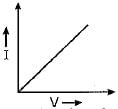
- c)
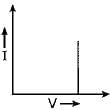
- d)

Correct answer is option 'B'. Can you explain this answer?
The graph between current I and potential difference V in the experimental verification of Ohm’s law were drawn by four students. Which one is correct ?
a)

b)

c)

d)

|
|
Soni Kumari answered |
B is correct because wo know that in ohm's law
v is directly proportional to I
so,in option B v increase and I is also increases.
v is directly proportional to I
so,in option B v increase and I is also increases.
Two light bulbs are marked 230 V; 75 W and 230 V; 150 W. If the first bulb has a resistance R, then the resistance of the second is;- a)2R
- b)(1/2)R
- c)4R
- d)(1/4) R
Correct answer is option 'B'. Can you explain this answer?
Two light bulbs are marked 230 V; 75 W and 230 V; 150 W. If the first bulb has a resistance R, then the resistance of the second is;
a)
2R
b)
(1/2)R
c)
4R
d)
(1/4) R
|
|
Pooja Shah answered |
Power = voltage * current
= Voltage * ( voltage / resistance)
Hence, if P is power, V is Voltage and R is resistance, then R = V ^2/ R
Hence for first bulb, R1 = V^2/75 = R
For second bulb, R2 = V^2 / 150
= > ½ (V^2/75) = R/2
=> R/2
= Voltage * ( voltage / resistance)
Hence, if P is power, V is Voltage and R is resistance, then R = V ^2/ R
Hence for first bulb, R1 = V^2/75 = R
For second bulb, R2 = V^2 / 150
= > ½ (V^2/75) = R/2
=> R/2
When a number of resistors are connected in parallel, then their resultant resistance is ______________ the smallest individual resistance.- a)Less than
- b)Sometime less and sometimes greater than
- c)Same as
- d)greater than
Correct answer is 'B'. Can you explain this answer?
When a number of resistors are connected in parallel, then their resultant resistance is ______________ the smallest individual resistance.
a)
Less than
b)
Sometime less and sometimes greater than
c)
Same as
d)
greater than
|
|
Krishna Iyer answered |
When the resistors are connected in parallel then the net resistance is less than or greater than the smallest individual resistance.
Chapter doubts & questions for Electricity - Science Class 10 2025 is part of Class 10 exam preparation. The chapters have been prepared according to the Class 10 exam syllabus. The Chapter doubts & questions, notes, tests & MCQs are made for Class 10 2025 Exam. Find important definitions, questions, notes, meanings, examples, exercises, MCQs and online tests here.
Chapter doubts & questions of Electricity - Science Class 10 in English & Hindi are available as part of Class 10 exam.
Download more important topics, notes, lectures and mock test series for Class 10 Exam by signing up for free.

Contact Support
Our team is online on weekdays between 10 AM - 7 PM
Typical reply within 3 hours
|
Free Exam Preparation
at your Fingertips!
Access Free Study Material - Test Series, Structured Courses, Free Videos & Study Notes and Prepare for Your Exam With Ease

 Join the 10M+ students on EduRev
Join the 10M+ students on EduRev
|

|
Create your account for free
OR
Forgot Password
OR
Signup on EduRev and stay on top of your study goals
10M+ students crushing their study goals daily


















